
Antennaria is a genus of dioecious perennial herbs in the family Asteraceae, native to temperate regions of the Northern Hemisphere, with a few species in temperate southern South America; the highest species diversity is in North America. Common names include catsfoot or cat's-foot, pussytoes and everlasting.
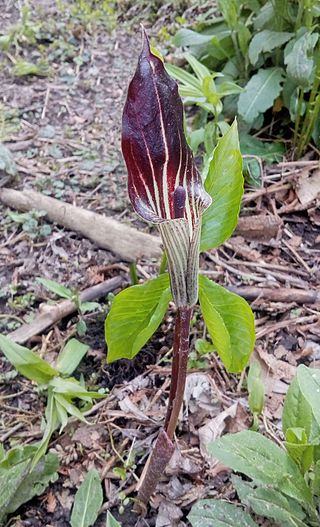
Arisaema triphyllum, the Jack-in-the-pulpit, is a species of flowering plant in the arum family Araceae. It is a member of the Arisaema triphyllum complex, a group of four or five closely related taxa in eastern North America. The specific name triphyllum means "three-leaved", a characteristic feature of the species, which is also referred to as Indian turnip, bog onion, and brown dragon.

Maianthemum racemosum, the treacleberry, feathery false lily of the valley, false Solomon's seal, Solomon's plume or false spikenard, is a species of flowering plant native to North America. It is a common, widespread plant with numerous common names and synonyms, known from every US state except Hawaii, and from every Canadian province and territory, as well as from Mexico.
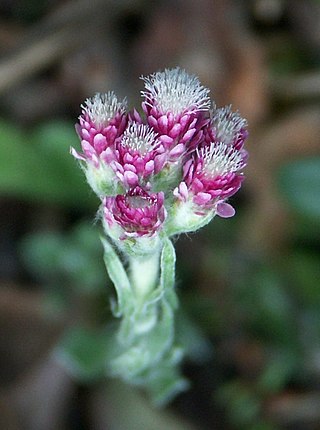
Antennaria dioica is a Eurasian species of flowering plant in the family Asteraceae. It is a perennial herb found in cool northern and mountainous regions of Europe and northern Asia (Russia, Mongolia, Japan, Kazakhstan, China and the Aleutian Islands of Alaska.

Dactylis glomerata is a species of flowering plant in the grass family Poaceae, known as cock's-foot, also colloquially as orchard grass, or cat grass (due to its popularity for use with domestic cats). It is a cool-season perennial C3 tufted grass native throughout most of Europe, temperate Asia, and northern Africa.

Galium album, common names white bedstraw and upright hedge bedstraw, is an annual, herbaceous plant of the family Rubiaceae and is native to much of Europe.

Ostrya virginiana, the American hophornbeam, is a species of Ostrya native to eastern North America, from Nova Scotia west to southern Manitoba and eastern Wyoming, southeast to northern Florida and southwest to eastern Texas. Populations from Mexico and Central America are also regarded as the same species, although some authors prefer to separate them as a distinct species, Ostrya guatemalensis. Other names include eastern hophornbeam, hardhack, ironwood, and leverwood.

Helianthus pauciflorus, called the stiff sunflower, is a North American plant species in the family Asteraceae. It is widespread across the Great Plains, the Rocky Mountains, and the Great Lakes region, and naturalized in scattered locations in the eastern United States and in much of southern Canada.

Antennaria corymbosa is a North American species of flowering plants in the family Asteraceae known by the common names flat-top pussytoes or meadow pussytoes. It is native to western Canada and the Western United States south as far as Tulare County in California and Rio Arriba County in New Mexico. It grows in moist, cool areas such as mountain meadows and riverbanks. Most of the populations are found in the Rocky Mountains, the Cascades, and the Sierra Nevada.
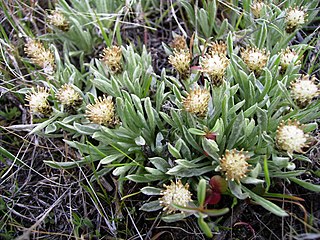
Antennaria dimorpha is a North American species of flowering plants in the family Asteraceae known by the common names low pussytoes or gray cushion pussytoes. It is native to western Canada and the western United States as far south as Riverside County in California and Rio Arriba County in New Mexico. It is generally found in dry areas. There are historical records of the species formerly occurring in northwestern Nebraska, but these populations appear now to be gone.

Antennaria luzuloides is a North American species of flowering plant in the family Asteraceae known by the common name rush pussytoes. The species is native to western Canada and the western United States.

Antennaria rosea is a North American species of flowering plant in the family Asteraceae known by the common name rosy pussytoes. Other common names include cat's foot and mountain everlasting. The second part of its scientific name, rosea, is Latin for pink.

Antennaria umbrinella is a North American species of flowering plants in the family Asteraceae known by the common names umber pussytoes and brown pussytoes. It is native to southwestern Canada and the western United States as far south as Colorado, Coconino County in Arizona, and Tulare County in California). It grows in a variety of habitats at a variety of elevations, from lowland sagebrush steppe to subalpine meadows.
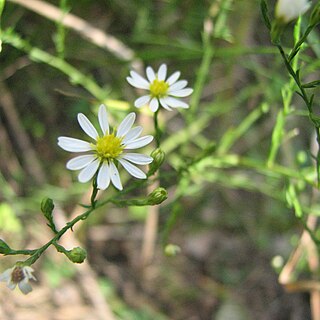
Symphyotrichum depauperatum, commonly known as serpentine aster or starved aster, is a rare species in the family Asteraceae adapted to serpentine barrens, an ecosystem with a high concentration of toxic metals in the soil. It has been found in Pennsylvania, Maryland, and on some diabase glades in North Carolina. It grows to 50 centimeters and has white ray florets surrounding a center of yellow disk florets.

Antennaria parvifolia is a species of flowering plant in the family Asteraceae, known by the common names small-leaf pussytoes and Nuttall's pussytoes. It is native to western and central North America.

Antennaria plantaginifolia is a perennial forb native to the eastern North America, that produces cream colored composite flowers in spring.

Sagittaria graminea, the grassy arrowhead or grass-leaved arrowhead, is an aquatic plant species native to eastern North America.
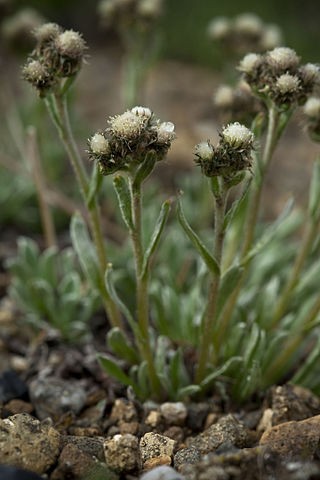
Antennaria friesiana, or Fries' pussytoes, is an Arctic species of plants in the family Asteraceae. It is the northern reaches of Asia and North America. Many of the populations lack male (staminate) flowers and reproduce asexually.
Antennaria pulchella is a North American species of flowering plants in the family Asteraceae known by the common names showy pussytoes and handsome pussytoes. It is widespread across much of Canada including the three Arctic Territories, as well as in parts of the United States.
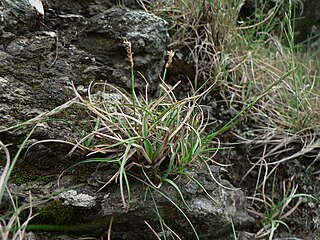
Carex rupestris, called the curly sedge and rock sedge, is a species of flowering plant in the family Cyperaceae, native to temperate and subarctic North America, Greenland, Iceland, Europe, and Asia.




















